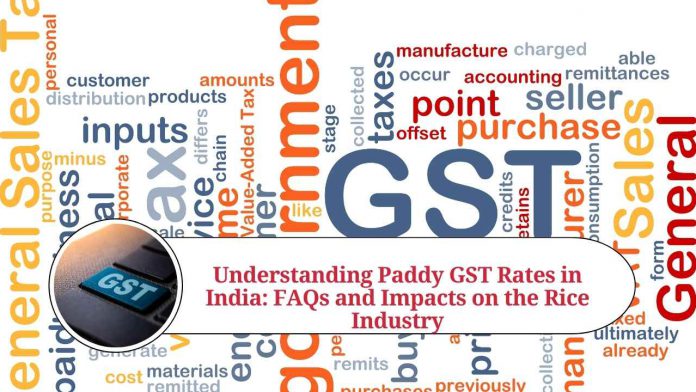Understanding Paddy GST Rates: A Comprehensive Guide
The Goods and Services Tax (GST) is a comprehensive indirect tax that has replaced various taxes such as Value Added Tax (VAT), Central Excise Duty, and Service Tax. Under GST, all goods and services are classified into various tax slabs, ranging from 0% to 28%.
One of the essential commodities in India is paddy, which is widely grown and used for various purposes, including consumption, export, and animal feed. In this blog, we will understand the GST rates applicable to paddy.
What is Paddy?
Paddy is an unhusked rice grain, commonly known as ‘rice in the husk.’ It is the most important cereal crop, grown extensively in India, China, and Southeast Asia. The unhusked paddy grain comprises the outer hull, the bran layer, and the starchy endosperm.
GST Rates on Paddy
Under the GST regime, paddy is exempted from tax, which means there is no GST applicable on the purchase or sale of paddy. However, it is important to note that GST is applicable to processed rice, which means rice that has been milled, polished, and dehusked.
GST Rates on Processed Rice
The GST rates applicable to processed rice vary based on the packaging and branding of the product. Let’s understand the GST rates in detail.
- Packaged Rice: Packaged rice refers to rice that is packed in containers with a registered brand name. The GST rate applicable to packaged rice is 5%.
- Non-Packaged Rice: Non-packaged rice refers to rice that is not packed or sold loose. The GST rate applicable to non-packaged rice is also 5%.
- Branded Rice: Branded rice refers to rice that is sold under a registered brand name. The GST rate applicable to branded rice is 5%.
- Unbranded Rice: Unbranded rice refers to rice that is not sold under a registered brand name. The GST rate applicable to unbranded rice is Nil.
Sure, let’s dive deeper into the topic of paddy GST rates.
Exemption of GST on Paddy
Paddy is one of the essential food grains in India, and it is exempted from GST as it is an unprocessed product. However, it is important to note that the exemption only applies to paddy and not to the by-products or residues obtained from it.
GST Rates on Processed Rice
Processed rice refers to rice that has undergone some processing, such as dehusking, polishing, and milling. It is an essential commodity, consumed widely in India and other countries. Under GST, the processed rice is classified based on the packaging and branding of the product.
- Packaged Rice: Packaged rice refers to rice that is packed in containers with a registered brand name. The GST rate applicable to packaged rice is 5%.
- Non-Packaged Rice: Non-packaged rice refers to rice that is not packed or sold loose. The GST rate applicable to non-packaged rice is also 5%.
- Branded Rice: Branded rice refers to rice that is sold under a registered brand name. The GST rate applicable to branded rice is 5%.
- Unbranded Rice: Unbranded rice refers to rice that is not sold under a registered brand name. The GST rate applicable to unbranded rice is Nil.
Impact of GST on Paddy and Rice Industry
The implementation of GST has had a significant impact on the paddy and rice industry in India. While the exemption of GST on paddy has helped farmers, the application of GST on processed rice has resulted in a higher tax burden for the rice millers and traders.
The GST rates on processed rice have led to increased compliance costs, as businesses need to maintain detailed records of their transactions. It has also resulted in an increase in the price of rice for consumers, as the higher tax rates are passed on to the end-users.
However, the GST has also brought some benefits to the industry, such as simplification of the tax structure and the elimination of multiple taxes that were previously levied on the supply chain of rice. It has also facilitated the growth of the organized sector in the industry and streamlined the supply chain operations.
Conclusion
In conclusion, paddy is exempted from GST, while processed rice is taxable under GST. The GST rates applicable to processed rice vary based on the packaging and branding of the product. The GST implementation has had both positive and negative impacts on the paddy and rice industry in India. Understanding the GST rates and compliance requirements is essential for businesses in the industry to ensure proper compliance and avoid penalties.
Read more useful content:
Frequently Asked Questions (FAQs)
What is paddy under GST?
A: Paddy is an unhusked rice grain, which is exempted from GST as it is an unprocessed product.
Is GST applicable on processed rice?
A: Yes, GST is applicable on processed rice, which includes milled, polished, and dehusked rice.
What are the GST rates applicable to packaged rice?
A: The GST rate applicable to packaged rice is 5%.
What is the GST rate applicable to non-packaged rice?
A: The GST rate applicable to non-packaged rice is also 5%.
What is the difference between branded and unbranded rice under GST?
A: Branded rice is sold under a registered brand name, and the GST rate applicable to it is 5%. On the other hand, unbranded rice is not sold under a registered brand name, and the GST rate applicable to it is Nil.
Is GST applicable to rice bran?
A: Yes, GST is applicable to rice bran as it is a by-product of paddy.
What is the impact of GST on the rice industry?
A: The GST implementation has had both positive and negative impacts on the rice industry in India. While the exemption of GST on paddy has helped farmers, the application of GST on processed rice has resulted in a higher tax burden for the rice millers and traders.
Can I claim input tax credit on GST paid on processed rice?
A: Yes, businesses can claim input tax credit on GST paid on processed rice, which can be set off against their output tax liability.
Is there any exemption from GST for rice exports?
A: Yes, exports of rice are zero-rated under GST, which means that the GST paid on inputs used for the production of exported rice can be claimed as a refund.
Do I need to register for GST if I am engaged in the paddy and rice industry?
A: Yes, if your turnover exceeds the threshold limit of Rs. 40 lakhs (Rs. 10 lakhs for northeastern states), you are required to register for GST and comply with its provisions.




















